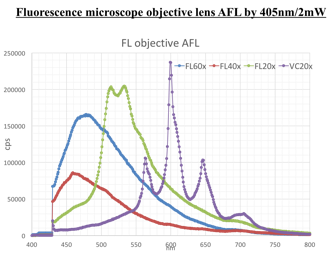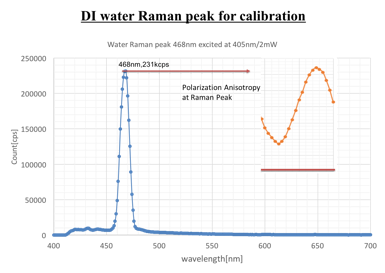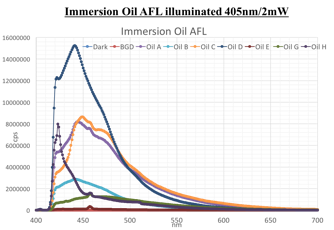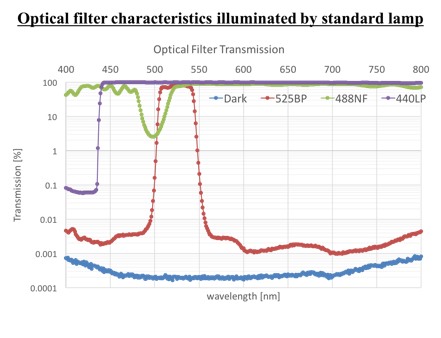Miftek’s LIPS-405 is based on Laser Induced Fluorescence (LIF) optics via 405nm laser excitation. Photon detection is a highly sensitive technique for material analysis or coating autofluorescence (AFL) evaluation. Every optical component that is illuminated by laser light must be carefully selected and checked for autofluorescence. Despite the fact that basic optics material for many lenses is quartz or even high-grade quartz or calcium fluorite, it is possible to observe autofluorescence and photo bleaching phenomena in many optical components. The LIPS-405 instrument facilitates the investigation of the causes for AFL in optical components. Perpendicular detection is also important for fluorescence analysis and this configuration does not require long-pass filters and it is possible to evaluate the full range spectrum of the monochromator.
Microscopy Objective Analysis

Despite the recognition that background measurements can be problematic in microscopy, it has been very difficult to perform quantitative analysis. Using LIPS system, it is possible to analyze autofluorescence even for extremely weak fluorescence in any optical system. For example glass slides and cover glass, immersion oil, objective lens or even the quartz flow chamber using in flow cytometers have specific autofluorescence spectra when illuminated by shorter wavelengths of light. Further, even high cost objective lens necessary for high resolution imaging can show relatively high AFL level shown. Autofluorescence evaluation of 4 commercial microscope objectives illuminated by 405nm are shown for FL60x (solid), FL40x (long dash), FL20x (short dash), VC20x (dash-dot). If conventional fluorescence measurement is recorded, depending on the objective used, users may experience certain background fluorescence signal just from the objectives. We are under investigating this area to determine procedures for the reduction of background fluorescence.
Raman water peak calibration

For the purposes of establishing an internal check on the spectrometer performance, we utilized DI water as a reference material on a daily basis. This analysis provided a Raman peak spectra from water peak at 468 nm excited by 405 nm where 468 nm peak corresponds to 3200 cm-1. The spectrum shows sufficient signal count. Further, if this technology is applied to conventional Raman spectroscopy or coherent antistoke Raman spectroscopy, the proposed large dynamic range and lower DCR will ensure to provide Raman peaks that might have conventionally been considered as “noise peaks” thus opening up more diverse band assignments to the corresponding chemical bonding information.
Evaluation of Immersion Oils
Liquid Analysis – Immersion Oils

We applied a wall-less liquid trapping method for liquid sample analysis. Use of this technique which allows for sample illumination in a co-axial direction is shown below. Sample thickness is about 4.5 mm requiring approximately 20 µl of sample in a 2.4 mm inner diameter tube.
Evaluation of Optical Filters

Several filter transmission characteristics are shown with detection limit by dark count level where transmission was calculated by output count/input count. By use of the logarithmic scale, it is possible to check absolute optical density (OD) performance and count total photon number through an optical filter in the appropriate bandwidth. Transmission characteristics of a 525 nm bandpass filter (solid), 488 nm notch filter (dash-dot), and 440 nm longpass pass filter (dotted) were shown for comparison. For example, 525 nm BP filter clearly shows 4 order of OD difference between pass and rejection band while the 488 notch filter only shows 1.5 order OD difference. A key contribution of the LIPS system is that even below 1 % transmission, the system can accurately quantify the photon count level between 0.001 to 1% range whereas in conventional spectroscopic systems, this is simply treated as noise level. This performance is again particularly beneficial in a situation where one needs to deal with extremely low level of analyte signal. Compared to conventional fluorescence measurement system, LIPS will be able to quantitate this level of lower signals by photon counts. It is necessary to consider that filter characteristics are highly dependent on illumination light condition, especially the incident angle and ambient light levels.
